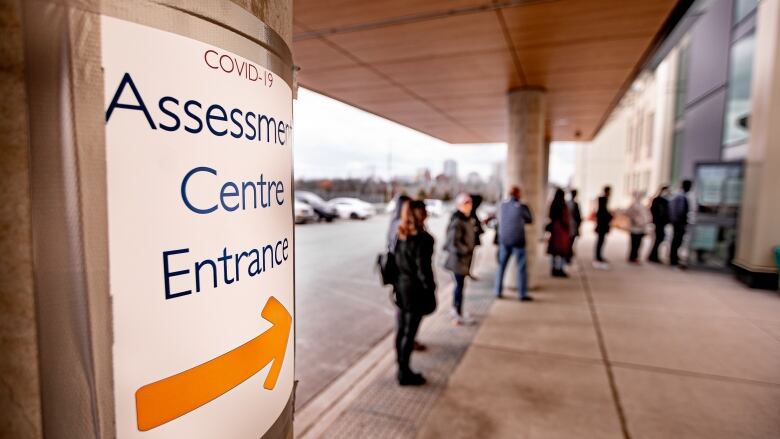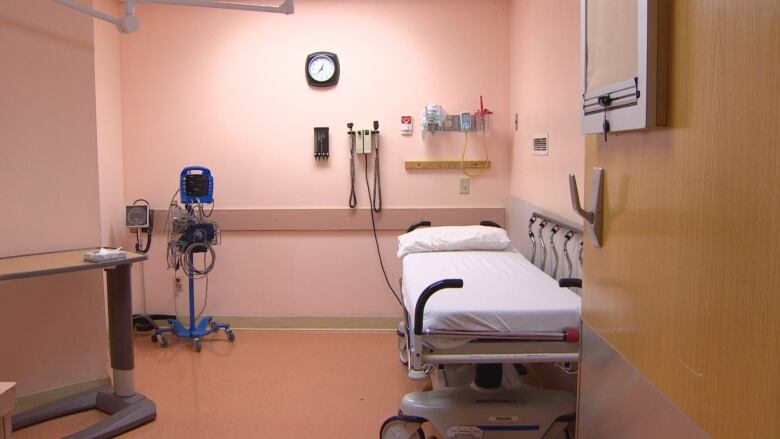N.W.T. health authorities reveal 'worst-case' COVID-19 pandemic plan
Plan outlines what would happen if widespread outbreak occurred

The Northwest Territories Health and Social Services Authority has released an updated pandemic response plan outlining how the territory's health system will respond to a worst-case scenario outbreak.
"The hardest is yet to come ... but we know that we can do this," said Dr. Sarah Cook, the territory's outgoing medical director, while announcing the plan on Friday.
The document is based on a similar pandemic response plan made for Alberta, and replaces a different pandemic plan released earlier this year.
It contains no mention of a new 150-person, $87 million COVID-19 "co-ordinated secretariat" announced Thursday, intended to clear up jurisdictional confusion within the government.
Instead, the plan calls the Emergency Operations Centre, a meeting of regional emergency response managers, "the central command and communications point" during an outbreak.
The decision to trigger one of the plan's four phases will be made by the territorial medical directorwho is soon to be replacedby Dr. AnneMarie Pegg, and the director of health services,Joanne Engram.
The plan "long predated the announcement of the COVID-19 secretariat," Cook said.
"It will be great to see how the secretariat is able to improve the efficiency of how various departments work together," she said, but emphasized the plan is focused on the health system's response only, not the territory's wider efforts.
A spokesperson later said the emergency operations centre is now considered part of the secretariat, though that would not necessarily changeanything about the plan.
Treatment to be centralized in Yellowknife
The plan generally calls for COVID-19 treatment and other "critical surge capacities" to be centralized in Yellowknife, with patients requiring care to be relocated there if necessary.
"We simply don't have the equipment and expertise in many small communities to care for someone who is severely sick with COVID-19," Cook said.
The plan limits use of resources in small communities and even regional hubs as much as possible.
The hospital in Inuvik would only be used for COVID-19 patients after Yellowknife's Stanton Territorial Hospital reaches capacity, and the health centre in Hay River would only take COVID-19 patients for "comfort care," a euphemism for end-of-life treatment.
The plan also tries to limit interruption to regular health services, encouraging the switch to virtual care before reducing services.
The plan is based on the assumption, consistent with a large-scale Chinese study from March, that "80 per cent" of COVID-19 cases will result in only mild symptoms. Even in the severest outbreak, most COVID-19 patients will be asked to isolate at home.

What happens in an outbreak?
The plan outlines four stages of a possible pandemic outbreak.
Stage one is triggered anytime a single patient is hospitalized for COVID-19. This has already happened once, when the territory's third case of COVID-19 was hospitalized at Stanton Territorial Hospital due to complications stemming from a pre-existing condition.
Immediately upon entering stage one, Yellowknife's hospital will prepare to increase its intensive care unit (ICU) capacity from four beds to six. A dedicated COVID-19 unit can also be created, for a total of 36 beds.Other health services requiring in-person care are reduced.
Stage two is triggered when there is community transmission, meaning spread among N.W.T. residents with unknown origin. The goal at that time is to "flatten the curve," and immediately reintroduce public health measures to prevent further spread.
There will be49 beds dedicated toCOVID-19 cases. Other health services are kept to the essentials.

When Stanton reaches 50 per cent of its patient capacity, stage three is triggered. At that point, health authorities will begin to focus on maintaining that capacity, and preventing the system from becoming overtaxed.
"Any space where mechanical ventilation is possible is utilized," the plan reads. "Hospitalized patients are accommodated in non-traditional space."
Some rooms are doubled, bringing total beds dedicated to COVID-19 cases to 63.
Pregnant mothers in Inuvik may be moved to Yellowknife to centralize care, and many other health services will be limited to emergencies.
Requests will go out to the federal government and other provinces to ready extra support if necessary.
Stage four occurs when the N.W.T. health system can take no more. All available resources are turned toward increasing capacity to the point that Stanton Territorial Hospital has 50 per cent of beds available or more.

External resources, like the Alberta health system or the Canadian Armed Forces, may be mobilized at this point, having been prepared for deployment in stage three.
All available beds in the hospital become COVID-19 beds, with the exception of eight ICU beds, and some moderate cases will be treated in Inuvik.
Even with all cylinders firing, the territory only has 11 ventilators available (another three are on order).
Recent research has identified possible substitutes for ventilators in many cases but the plan acknowledges, if a serious outbreak occurs, some difficult decisions may need to be made.
How will the government decide whose life is saved?
Knowing the limits of the system means accepting the possibility that the N.W.T. won't be able to care for everyone.
The plan doesn't mince words when it comes to the worst-case scenario. Facing an overtaxed system, health workers may have to make decisions about who receives "life-saving care."
To mitigate the influence of "arbitrary criteria or unchecked biases," the plan includes an "ethical framework" that evaluates decisions against a list of value statements.
But the questions included on the form, the same oneused in Alberta,deal mostly with bureaucratic considerations.
At the highest level, those include questions like:
- Does this decision minimize harm to the public and the risk of spread?
- Does it provide health workers with the supports they need to minimize their own risk?
- Does this disproportionately impact vulnerable residents, or create additional barriers to care?
Allowing "those closest to clinical decisions to exercise clinical judgment" is included at the lowest level, alongside asking if policies align with provinces or the federal government.
Ultimately, thismeans that when faced with difficult ethical decisions, health workers will also be faced with another government form.
When it's completed, it's to be submitted to the "scarce resource triage committee," which includes an Indigenous elder, an ethicist from Alberta, and health-care providers.
Dr. Cook couldn't say if there was a way for patients or their families to appeal their decisions.
Why a new plan now?
In a briefing accompanying the release of the plan, Dr. Cook said the plan was developed and shared with staff some time ago.
"It's being presented publicly now, but it's not because there have been any changes in the overall pandemic plan," she said.
A summary accompanying the plan says the government hopes making it public will encourage transparency, "build confidence" in the system, and help residents understand the limited health capacity in the territory.
WATCH | Miss the briefing? Catch the full announcement here:
The release of the plan follows on several other developments with health services Thursday.Health authorities announced new protocols making masks mandatory in health clinics, hospitals and other health authority facilities and offices starting Sept. 14.
Drive-thru COVID-19 testing will also resume in Yellowknife next week.
Thursday, following the announcement of the new COVID-19 secretariat, Premier Caroline Cochrane said her greatest fear heading into the fall was "complacency."
"That is my biggest fear that people go back to thinking that they're safe," she said.
N.W.T. Chief Public Health Officer Kami Kandola has said repeatedly that it's only a matter of time until the N.W.T. sees more COVID-19 cases.
(PDF KB)
(Text KB)CBC is not responsible for 3rd party content
With files from Katherine Barton












_(720p).jpg)


 OFFICIAL HD MUSIC VIDEO.jpg)
.jpg)



























































































